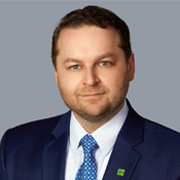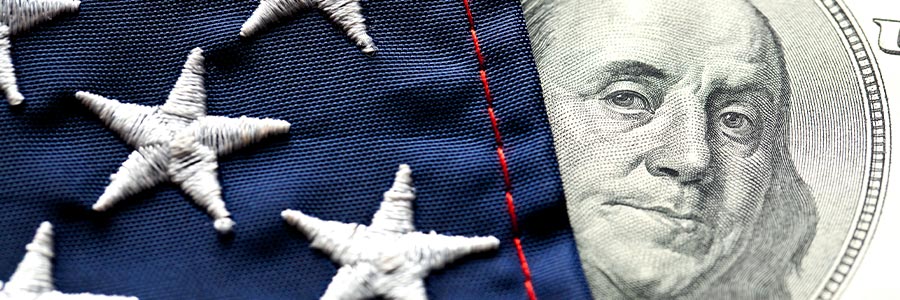U.S. Economy and the Fed: De-escalating our Forecasts
By: Oscar Munoz, Gennadiy Goldberg, Molly Brooks, Jan Nevruzi
May 15, 2025 - 7 minutes 30 seconds
Overview
- The trade-war truce between the U.S. and China marks a major de-escalation. The near-term outlook for economic activity has improved, but the effective tariff rate will remain historically elevated. We still look for the shock to inflation to be significant.
- We see less urgency for monetary policy support in the near term. A more constructive short-term trajectory for activity and the labor market should allow Fed officials to remain prudent as the economy absorbs the incoming jolt from higher tariffs.
- Change of View: We now look for the FOMC to implement two 25 basis points rate cuts this year, in October and December, with the pace of easing turning more gradual next year reaching the neutral rate at 3% by Q4 2026.
- U.S. Rates: Trade de-escalation, lower recession odds and a delay to cuts have led us to raise our year-end forecast for 10-year Treasuries to 4% and to 3.5% by the end of 2026. The curve is likely to continue steepening as investors worry about the budget, term premium, and demand.
The Art of the Deal
The 90-day trade policy détente announced by the U.S. and China marks a major de-escalation between the two countries. According to the temporary agreement, tariffs on imports this year will fall by 115pp on each side to 30% on Chinese goods and to 10% on US goods.
In our view the U.S./China trade shift carries two key takeaways for U.S. economy:
- Policy is pivoting from “Tariff Man” to the “Art of the Deal”. The Trump administration now appears less ideological than we had initially assumed regarding trade policy, with the administration now willing to de-escalate tensions in order to score wins through bilateral trade deals.
- The uncertainty shock triggered after “Liberation Day” has been greatly reduced. The left tail risk for growth outcomes has shrunk, which will likely translate into easier financial conditions that should help to support activity in the near term. We're reducing our projected odds for recession from a coin toss to 35%.
Escalate to De-escalate: U.S. Tariffs on Chinese Goods
Despite declining, the effective tariff rate will remain historically elevated. We expect the level to settle at around 20% assuming tariffs on Sections 232 & 301 remain in the picture. This means the shock to inflation will continue to be significant, though more protracted and less acute than what we had initially penciled in. We still look for the bulk of the month-over-month passthrough to consumer prices to occur in June and July, but now project higher August inflation as well. We now forecast the peak of core CPI inflation to come in at 3.8% in Q3 2025 with inflation closing the year slightly lower at 3.7% Q4 over Q4 in 2025 and at 2.6% Q4 over Q4 in 2026.
The outlook for economic activity has nevertheless improved as the left tail risk for growth outcomes has been greatly reduced. A sudden stop in commerce between the U.S. and China, leading to supply-chain disruptions, empty shelve, and climbing layoffs, isn't likely to come to fruition. In fact, rising shipping demand and restocking will be drivers of economic activity over the next few months. All in, we still look for below-trend economic growth, but no longer forecast a contraction in Q3 economic activity. We now project GDP growth to close the year at 0.8%, up from our earlier forecast of 0.2% Q4 over Q4. We also estimate the unemployment rate to rise to 4.6% by the end of the year, down from 4.8% before.
Big Beautiful Cuts
Given our new assumptions for the U.S. economic outlook, we see less urgency for monetary policy support in the near term. A more constructive short-term trajectory for activity and the labor market should allow Fed officials to remain prudent as the economy absorbs the incoming jolt from higher tariffs. We continue to anticipate the bulk of the tariff shock to impact inflation over the summer and to increasingly weigh on the labor market towards the end of Q3.
Fed leadership has made it crystal clear that, amid rising inflation in the near horizon, the bar for easing has moved higher. Policymakers are squarely focused on inflation outcomes as inflation is the part of the mandate that remains further away from its target. In that context, Fed officials will wait for labor market conditions to show clear deterioration before they start to shift their focus away from the inflation mandate. We now expect the activity and labor market data to prove broadly resilient in Q2 but to lose clear momentum in Q3 as higher prices will start to increasingly dent real incomes and profit margins start to shrink.
This should set up the Committee for easing in October. By the time of that meeting, we expect most of the inflation passthrough to have materialized. The September CPI report will be instrumental for confirming that the lion's share of the tariff transmission to consumer prices is over. This should also help to keep long-term inflation expectations contained.
The upshot is that we now look for the FOMC to ease by 25bp in consecutive meetings starting in October and ending in January as the Committee will try to catch up with policy normalization once the tariff impact is confirmed as largely temporary. Softer employment conditions, evidenced by a slowly rising UE rate, should also play a role. As we've noted before, we don't think a recession is necessary for the Fed to begin policy easing.
We then expect the FOMC to slow the frequency of rate cuts to a quarterly pace starting in Q2 2026 and ending in Q4 where we anticipate the Committee will reach the neutral rate of 3%. We no longer see the need for the FOMC to ease rates below neutral as we had assumed following the Liberation Day tariffs announcement.
We continue to acknowledge significant risks to our view as uncertainty stays elevated and government decisions around trade policy remain fluid.
U.S. Rates: Yields to Decline, But Slowly
The Fed cutting profile will remain a difficult one for rates investors to position for, favoring those investors who can look through near-term volatility and buy dips at more attractive levels. While there has been some de-escalation on the tariff front, we expect volatility to remain elevated as trade discussions continue and the market struggles for direction. However, we still expect the Fed's policy rate to decline over time as economic data momentum moderates, which should push yields gradually lower. Given the change to our Fed view and a lower probability of recession (35% from 50% previously), we push our year-end forecast for 10-year Treasury yields notably higher to 4% from 3.3% earlier and look for them to finish 2026 at 3.5% compared with 3% previously.
There are several notable changes to our forecast:
- Slower downturn in rates: Given our less aggressive profile for rate cuts, we expect rates to decline more moderately with 10-year rates finishing the year at just 4%. This decline is likely to be driven by the market's pricing for rate cuts as economic data softens in the second half of the year with inflation viewed as being under control. We expect the 10-year to range in the 4.0-4.5% area in the coming months, with markets continuing to trade the two-cut versus four-cut range for the time being.
- Risks to ongoing steepening: Another factor we account for more fully is the higher term premium and a steeper curve given concerns about U.S. fiscal policy and worries about a lack of demand from foreign investors. While our revision of the terminal Fed funds rate estimate to 3% from 2.5% will keep rates markets pricing closer to neutral, we expect the curve to be notably steeper than macro indicators would predict. Trade de-escalation is likely to aid some decline in term premium and a richening of Treasuries versus overnight indexed swaps (OIS) and swaps, but term premium is likely to remain somewhat elevated given the potential for further volatility and expanding deficits. We now see the 10-year reaching an end point of 3.5% as the curve remains steeper — up from 3% previously. In addition, we see the U.S. 5-year 30-year curve reaching 100bp at year-end and a peak of 120bp in the cycle.
Investors are likely to remain cautious on duration, but we view the current environment as one where Treasuries should trade in tactical ranges. We expect buying dips in the 2-5-year sector to outperform as investors are unwilling to pencil out all rate cuts, keeping a minimum of two cuts and a maximum of four cuts in play for 2025 for the time being. This sets the range in 10-year Treasuries between 4% and 4.5%, and we expect that dip-buying nominal rates will remain highly attractive as rates will likely continue to gradually come down over the coming year.
Subscribing clients can read the full report, US Economy and the Fed: Deescalating our Forecasts, on the TD One Portal













